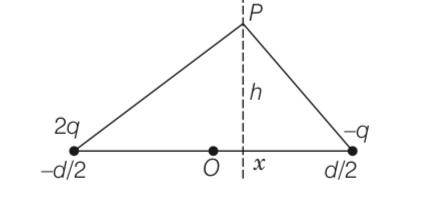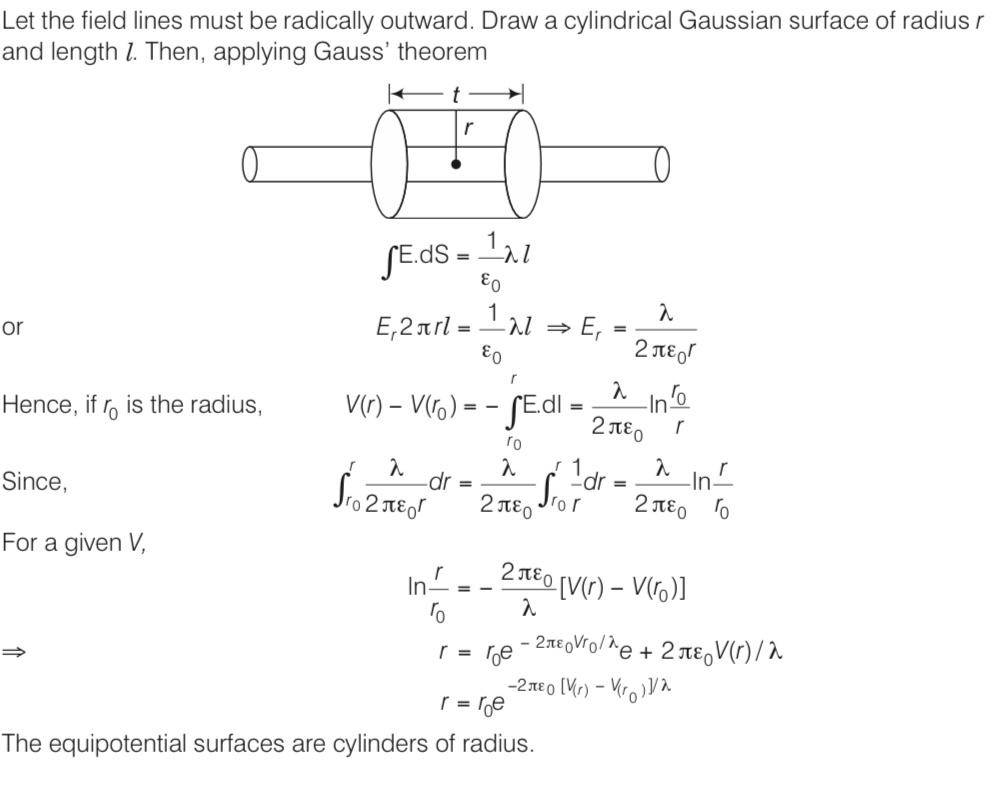Electrostatic Potential and Capacitance
Get insights from 125 questions on Electrostatic Potential and Capacitance, answered by students, alumni, and experts. You may also ask and answer any question you like about Electrostatic Potential and Capacitance
Follow Ask QuestionQuestions
Discussions
Active Users
Followers
New answer posted
5 months agoContributor-Level 10
This is a long answer type question as classified in NCERT Exemplar
As we know that, =charge/Area
Q1= (4 2)
Q2= (4 2)= 4Q1
when they come in contact with each other potential being same and charge will be conserved.
So net charge is 5Q1= 5 ( (4 2)
Also V1=V2
KQ1/R=KQ2/2R so Q1=Q2/2
Q1= (4 2) and Q2= (4 2)
=5 /3 and =5 /6
New answer posted
5 months agoContributor-Level 10
This is a long answer type question as classified in NCERT Exemplar
Potential energy of system of charges be algebraic sum
U =
9 109/10-15 (1.6 -19)2 (1/3)2- (2/3) (1/3)- (2/3) (1/3)
-7.68 10-14J
-7.68 10-14 -19= 0.48Mev
New answer posted
5 months agoContributor-Level 10
This is a long answer type question as classified in NCERT Exemplar
To lift the disc ther must be some electrostatic force is reqired.
F=qE……. (1), E=V/d………. (2)
But the charge required during the process is - 0 r2, using this relation in 1 and 2
F=- 0 r2V/d…… (3)
Also to balance something F=mg……. (4)
From equation 3 and 4
Mg= - 0 r2V/d, so V = 2 this the requird solution.
New answer posted
5 months agoContributor-Level 10
This is a long answer type question as classified in NCERT Exemplar
To lift the disc ther must be some electrostatic force is reqired.
F=qE……. (1), E=V/d………. (2)
But the charge required during the process is - 0 r2, using this relation in 1 and 2
F=- 0 r2V/d…… (3)
Also to balance something F=mg……. (4)
From equation 3 and 4
Mg= - 0 r2V/d, so V = 2 this the requird solution.
New answer posted
5 months agoContributor-Level 10
This is a long answer type question as classified in NCERT Exemplar
-
If net potential is zero then,
=

2dx= 0 , x=0
X=0 , y-z plane.
New answer posted
5 months agoContributor-Level 10
This is a long answer type question as classified in NCERT Exemplar

New answer posted
6 months agoContributor-Level 10
2.36 We do not get an electric shock as we step out of our house because the original equipotential surfaces of open air changes, keeping our body and the ground at the same potential.
Yes, the person will get an electric shock if he touches the metal slab next morning. The steady discharging current in the atmosphere charges up the aluminium sheet. As a result, its voltage rises gradually. The raise in the voltage depends on the capacitance of the capacitor formed by the aluminium slab and the ground.
The occurrence of thunderstorm and lightning charges the atmosphere continuously. Hence, even with the presence of discharging current of
New answer posted
6 months agoContributor-Level 10
2.35 According to Gauss's law, the electric field between a sphere and a shell is determined by the charge on a small sphere. Hence, the potential difference, V, between the sphere and the shell is independent of charge . For positive charge , potential difference V s always positive.
New answer posted
6 months agoContributor-Level 10
2.34 Equidistant planes parallel to the x-y plane are the equipotential surfaces.
Planes parallel to the x-y plane are the equipotential surfaces with the exception that when the planes get closer, the field increases
Concentric spheres centered at the origin are equipotential surfaces.
A periodically varying shape near the given grid is the equipotential surface. This shape gradually reaches the shape of planes parallel to the grid at a larger distance.
New answer posted
6 months agoContributor-Level 10
2.33 Potential rating of the capacitor, V = 1 kV = 1000 V
Dielectric constant of a material, = 3
Dielectric strength = V/m
For safety, the field intensity should not cross 10% of the dielectric strength, hence
Electric field intensity, E = 10 % of = V/m
Capacitance of the parallel plate capacitor, C = 50 pF = 50 F
Distance between the plates, d is given by d = = m = m
Capacitance is given by the relation
C = , where = permittivity of free space = 8.854
50 =
A = 1.88 = 18.8
Hence, t
Taking an Exam? Selecting a College?
Get authentic answers from experts, students and alumni that you won't find anywhere else
Sign Up on ShikshaOn Shiksha, get access to
- 65k Colleges
- 1.2k Exams
- 679k Reviews
- 1800k Answers
